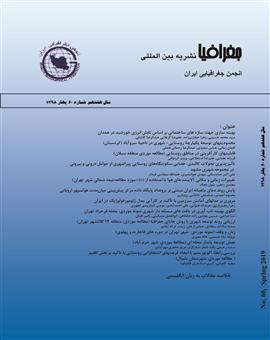پایش روند دمای ماهیانه ایران مبتنی بر برونداد پايگاه داده مركز پیشبینی میانمدت هواسپهر اروپایي (ECMWF) نسخه ERA Interim
محورهای موضوعی :محمود احمدی 1 , عباسعلی داداشی رودباری 2
1 - شهید بهشتی
2 - دانشگاه شهید بهشتی
کلید واژه: روند دما, پایگاه ECMWF, روش Mann–Kendall, روش Sen’s Slope, ایران,
چکیده مقاله :
نقش دما و اهمیت دگرگونی آن باعث شده است که طی چند دهه اخیر توجه جدی به این پدیده آبوهوایی شود. روند رو به رشد دما در برخی از مناطق ایران و پیامدهای احتمالی آن منجر به نگرانی جدی برای پژوهشگران و برنامهریزان شده است.هدف از این پژوهش دگرگونی مکانی روند دمای ایران طی چهار دهه اخیر می باشد. برای ارزیابی این روند از پايگاه داده مركز پیشبینی میانمدت هواسپهر اروپایي (ECMWF) نسخه ERA Interim طی دوره زمانی 1979 - 2015 میلادی با تفکیک مکانی 125/0×125/0 درجه قوسی برای هر ماه با 9966 یاخته استفاده شد. و جهت آشکارسازی روند دما از دو روش ناپارامتریک Mann–Kendall و Sen’s Slope بهره گرفته شد. نتایج نشان داد ، چهار ماه فوریه، مارس، می و اکتبر روند دمایی یک جهته (افزایشی) را تجربه کردهاند. بیشینه متوسط آهنگ روند افزایشی کشور مربوط به فصل زمستان و کمینه آن متعلق به فصل پاییز بوده است. در تمامی ماههای سال مناطقی از کشور که بین مدار 30 تا 35 درجه شمالی قرار داشتهاند بیشینه روند معنادار افزایشی را تجربه کردهاند. قلمرو مناطق سرد و معتدل کشور بیش از سایر مناطق دستخوش افزایش روند دما بودهاند. همچنین روند منفی جنوب شرق و جنوب (سواحل بوشهر) ایران ناشی از چهار دلیل: 1- دگرگونی خرد آبوهواشناسی محل؛ 2- افزایش هواویزهای هواسپهری؛ 3- بخارآب قابل بارش و 4- ابرها و دامنه دگرگونی دما، هستند. بیشینه متوسط شیب دمایی کشور با 11/0 درجه سانتی گراد مربوط به ماه فوریه و کمینه آن نیز به با 002/0 درجه سانتیگراد در ماه نوامبر اتفاق افتاده است. بهطورکلی زمستانهای ایران در حال گرمتر شدن است و این امر یک خطر جدی برای کانونهای برفگیر کشور تلقی خواهد شد.
The role of temperature and the importance of its transformation has led to a serious attention to this climate over the last few decades. The rising temperature in some regions of Iran and its possible implications have led to serious concerns for researchers and planners. The aim of this study is to determine the spatial transformation of Iran's temperature over the past four decades. In order to evaluate this trend, the ERA Interim European Centre for Medium-Range Weather Forecasts (ECMWF) database was used during the 1979-2015 period with a spatial resolution of 12566 × 125/0 ° arc per month with 9966 cells. Non-parametric Mann-Kendall and Sen's Slope methods were used to reveal the temperature trend. The results showed that four months of February, March, May and October experienced a one-way (incremental) temperature trend. The highest average of the country's seasonal increase was due to the winter season and its minimum was fall season. In all months of the year, the regions of the country that were between 30 to 35 degrees north have experienced the most significant incremental trend. The cold and temperate regions of the country have been experiencing higher temperatures than other areas. Also, the negative trend of south-east and south (Bushehr coastal areas) of Iran is due to four reasons: 1. Mineralization of the climate of the area; 2. Increased airborne weather conditions; 3. Precipitation vapor; and 4. Clouds and range of temperature changes. The maximum average temperature gradient of the country was at 11.1 ° C in February, and its minimum level was as high as 0.002 ° C in November. In general, Iran's winters are getting warmer, and this will be considered a serious threat to the country's flood victims.
